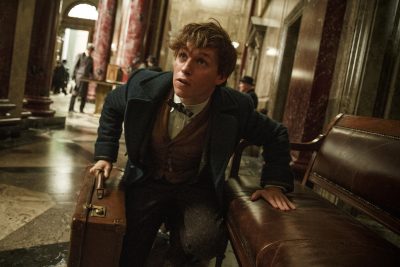
Director David Yates would have been hard-pressed to find a better setting than the 1920s, arguably the most popular decade in American history, to combine with J.K. Rowling’s famous wizarding world in the new Harry Potter franchise film, “Fantastic Beasts and Where to Find Them.”
As the original Potter generation grows into adults, Yates strives to do the same with the film’s characters. Eddie Redmayne plays protagonist Newt Scamander, a kooky and slightly bow-legged adult man — though he sometimes acts a bit like a child — who has a fascination with magical creatures.
Called a “muggle” in England, “no-maj” Jacob Kowalski (Dan Fogler), is an average Joe-type with zero prospects but a strong American dream. Rounding out the cast is Porpentina “Tina” Goldstein (Katherine Waterston), a disgraced magical law enforcement agent and her sister Queenie Goldstein (Alison Sudol), the quintessential flapper, who is also skilled in legilimency, allowing her to read minds.
Historically, the Potter franchise has been lacking on the diversity front, with a total of 12 people of color with speaking roles in the last eight films. “Harry Potter and the Cursed Child” attempted to change this by casting a black woman as Hermione in the stage production.
“Fantastic Beasts” continues this disappointment, though it should be noted that Madam President of the Magical Congress of the United States, played by Carmen Ejogo, is a treat to watch as she exudes power and prowess. That is, for the 50 or so seconds she’s given screen time.
The deceptive first scene is a glimpse of New York City and the Statue of Liberty, bathed in sunlight like the beacon it was to so many. After the sweet moment, “Fantastic Beasts” transitions to shades of industrial grey, reminiscent of the last four Potter films (also directed by Yates). The film feels a little off kilter; it’s something more real, rooted in despair and fear, than the main franchise.
Fundamentally, this is not a film about beasts, even though the animals are beautifully animated. The clingy bowtruckle, a stick-like creature that is sure to capture hearts, is a hero while the platypus-looking, gold-loving niffler makes for some great slow motion action shots, along with many others.
“Fantastic Beasts” has surprisingly dark undertones. Scamander starts the film by walking straight into an anti-magic rally led by Mary Lou Barebone (Samantha Morton). As the matriarch of a home of adopted children, it’s easy to dismiss her presence. However, scenes with Credence (Ezra Miller), her adopted son, and the punishments she doles out off-screen are terrifying. She instills in the children a sense of hate toward the “other”: magical beings.
The extremist rhetoric spewed throughout the film has more in common with present times than expected. As the United States undergoes a massive change in mood, this film comes at a perfect time to show younger citizens what that looks like. Newt, like the original movies’ Neville Longbottom, is perhaps easy to overlook, but preaches kindness and understanding towards the no-majs, wizards, witches and creatures.
Trusting in the magical government, Tina Goldstein turns Scamander in to get back into the Congress’ good graces, but the action backfires. Instead, we are introduced to Percival Graves (Colin Farrell), right-hand man to Madam President. With him, it is immediately clear he will not be on the “good side.” It seems slicked-back hair is the choice of burgeoning evil characters, à la Draco Malfoy. His role remains murky until the very end, leaving audience members speechless.
Perhaps the most interesting character, however, is Credence. Like his adopted mother, he seems forgettable. However, we discover that he is contact with none other than Graves. The relationship is sick at best — without spoiling too much, Credence relies on Graves as a chance at something better in life. The strain of abuse is clear in his mannerisms, from the downtrodden persona to the slight jitters he gets.
It is Credence, rather than Newt, who acts as a foil to the Boy Who Lived. With his parents out of the picture, Credence holds onto his sanity by a mere thread. This could have been Harry’s fate, and it’s sobering to see the boy, on the cusp on manhood, be consumed with this confusion and rage.
As a first-time screenplay writer, Rowling does a decent job. She gives more than enough plot to keep an audience satisfied, even inserting nuggets for the die-hard Potter fans, such as a headline detailing soccer’s prominence in the American wizarding world. Though a 600-page novel would have given her more room to flesh out details and backstories, she makes a valiant effort in just over two hours.
Given the recent announcement of a five-film deal, Rowling has time to hammer out details and give each plotline the attention it deserves.
























































































































